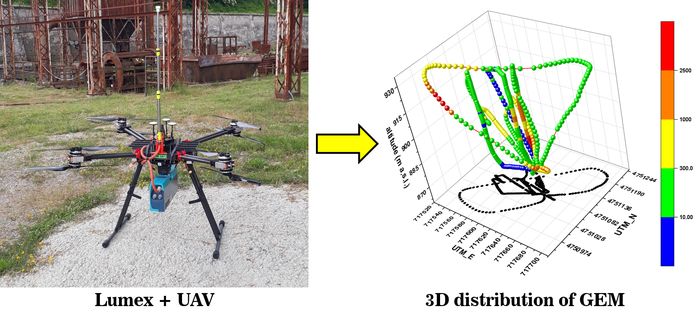Continuous and near real-time measurements of gaseous elemental mercury (GEM) from an unmanned aerial vehicle (UAV): a new approach to investigate the 3d distribution of gem in the lower atmosphere

A new paper, focused on the very first real attempt to directly and continuously measure gaseous elemental mercury (GEM) by means of a Lumex RA-915M mounted on an Unmanned Aerial Vehicle (UAV, a heavy-lift octocopter), has been published in Chemosphere.
The UAV-Lumex combination allowed to recognize the air concentration variability between different sites and to identify sudden mercury changes around the emission sources inside and outside the former Hg-mining area of Abbadia San Salvatore (Mt. Amiata, central Italy), known as a GEM source.
The resulting dot-map graphical representations provided a realistic 3D picture of GEM distribution during the UAV flight in near real-time. They are useful to verify whether guideline concentrations indicated by international, national or local authorities were exceeded and consequently to undertake appropriate actions to mitigate the possible risk for the local community and to successfully implement the Minamata Convention on Mercury by means of emerging investigation techniques for GEM atmospheric monitoring.
The presented instrumental approach is therefore able to overcome the limitations of both fixed measuring stations, which cannot take into account the GEM spatial variability, and passive samplers, which do not provide indications on sudden concentration variations in short periods.
The article is the result of a joint work between: Department of Earth Sciences of the University of Florence, Institute of Geosciences and Earth Resources (IGG) of National Research Council of Italy (CNR), Drone Arezzo S.r.l. and Unione dei Comuni Amiata - Val d'Orcia.
Bibliographic reference:
J. Cabassi, M. Lazzaroni, L. Giannini, D. Mariottini, B. Nisi, D. Rappuoli, O. Vaselli. Continuous and near real-time measurements of gaseous elemental mercury (GEM) from an Unmanned Aerial Vehicle: A new approach to investigate the 3D distribution of GEM in the lower atmosphere. Chemosphere, Volume 288, Part 2, 2022, 132547, ISSN 0045-6535. https://doi.org/10.1016/j.chemosphere.2021.132547.
Article available at: https://www.sciencedirect.com/science/article/pii/S0045653521030198.
For more information:
Jacopo Cabassi – jacopo.cabassi(at)igg.cnr.it